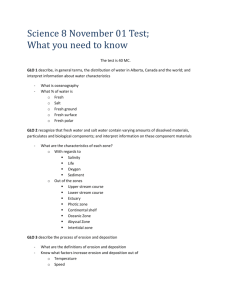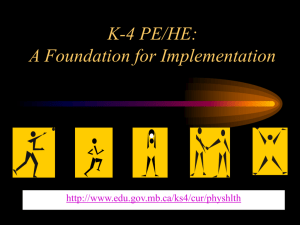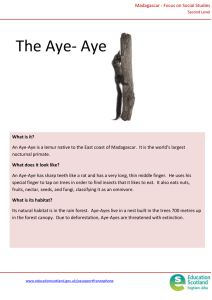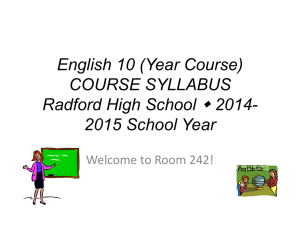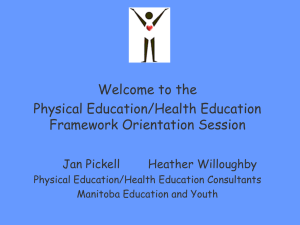Grade 4, Cluster 2: Light
advertisement
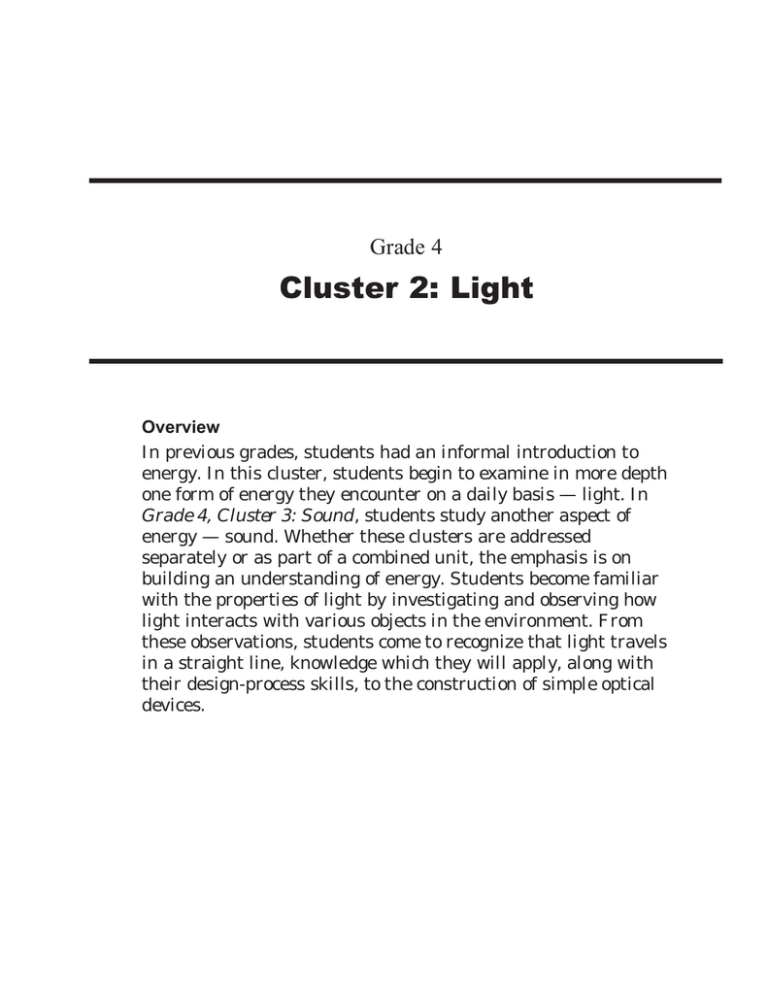
Grade 4 Cluster 2: Light Overview In previous grades, students had an informal introduction to energy. In this cluster, students begin to examine in more depth one form of energy they encounter on a daily basis — light. In Grade 4, Cluster 3: Sound, students study another aspect of energy — sound. Whether these clusters are addressed separately or as part of a combined unit, the emphasis is on building an understanding of energy. Students become familiar with the properties of light by investigating and observing how light interacts with various objects in the environment. From these observations, students come to recognize that light travels in a straight line, knowledge which they will apply, along with their design-process skills, to the construction of simple optical devices. Kindergarten to Grade 4 Science: A Foundation for Implementation SUGGESTIONS FOR INSTRUCTION PRESCRIBED LEARNING OUTCOMES Students will... 4-2-01 Use appropriate vocabulary related to their investigations of light. â Introduce, explain, use, and reinforce vocabulary throughout this cluster. Include: energy, reflect, absorb, transmit, artificial, light beam, transparent, translucent, opaque, technological development, science, brightness. GLO: A5, B1, C6, D4 4-2-02 Give examples of various forms of energy. Include: light, heat, food, sound. GLO: D4, E4 â Forms of Energy Use a Thinking Map to assist recall and organization of prior knowledge and to develop shared knowledge about various forms of energy. (Note: Thinking Maps are discussed in ELA, Strategies, p. 49.) Example: 4-2-03 Recognize that energy is an integral part of daily life. GLO: B1, D4, E4 4-0-4e. Identify problems as they arise, and work with others to find solutions. GLO: C3, C7 4-0-6d. Sort and classify according to an established classification system. (Math PRII.2.4) GLO: C2, C3 4-0-7e. Communicate results and conclusions in a variety of ways. Examples: point-form lists, sentences, graphs, labelled diagrams, charts... (ELA 2.3.5, 4.2.5; Math SP-III.1.4, SP-III.2.4; TFS 2.1.4) GLO: C6 stove drums fire Sound Heat echo Energy Sun Light light bulb lasers Food fruit bread â Observing the Environment — Finding Energy Have students work in pairs to list examples of energy found in their school building and schoolyard. Students then work with another pair to sort and categorize the energy examples according to the form of energy. Students may put the same example into more than one category. Use a Sharing Circle to have each group share their chart. (Note: Sharing Circle is discussed in ELA, Strategies, p. 106.) â Light Energy Have students draw pictures in their science journals representing light as a form of energy. 4. 20 Grade 4, Cluster 2: Light TEACHER NOTES Planning Note: Outcomes 4-2-02 and 4-2-03 are similar to outcomes 4-3-02 and 4-3-03 in Cluster 3: Sound. If the class has already studied sound energy, a quick review of energy with a “light” focus would be sufficient. Energy is a very important, yet challenging concept in science. It is recommended that students at this level talk about and use the term “energy” before they are able to define it. An appropriate working definition would be that energy makes things go, run, or happen. (See American Association for the Advancement of Science, Benchmarks for Science Literacy, p. 81.) SUGGESTIONS FOR ASSESSMENT Science Journal Entry: Energy Student directions: In your science journal, draw four pictures to show a variety of forms of energy found in your home. Be sure to label your pictures with the form of energy and its location. Look for q four pictures drawn q clearly labelled q a variety of energy forms shown q work neatly done In later years, students will work towards the more formal definition of energy as the ability to do work. Energy can be identified through things such as movement, heat, electricity, magnetic attraction, gravity, sound, and light. Energy can also be stored and used at later times (potential energy). 4. 21 Kindergarten to Grade 4 Science: A Foundation for Implementation SUGGESTIONS FOR INSTRUCTION PRESCRIBED LEARNING OUTCOMES Students will... 4-2-04 Demonstrate that white light can be separated into colours. GLO: C2, D4 4-0-7a. Draw a conclusion based on evidence gathered through research and observation. GLO: A1, A2, C2 4-0-7b. Identify new questions that arise from what was learned. (ELA 3.3.4) GLO: A1, C2, C3 4-2-05 Distinguish between objects that produce their own light and those that reflect light from another source. â Investigating Colours Have students hold a prism in sunlight to observe the colour of the rays that are separated onto a white paper background. Ask the following questions: • What do you see when the light passes through the prism? • Are the colours all the same? What are the colours? • Why does this happen? • What does this tell you about white light? â Produce or Reflect? Have students work in small groups to sort a variety of pictures into two categories. Provide a word list and categories. (See Success for All Learners, 6.33-6.35.) Examples: the Sun emits its own light, the Moon reflects light from the Sun... Produce Own Light Reflect Light from Other Sources fireflies bicycle reflector GLO: A1, A2, D4 Sun moonlight on water 4-2-06 Identify a variety of natural and artificial light sources. stars planets light bulb Moon Examples: Sun, candle, light bulb, firefly, lightning, aurora borealis, lasers... GLO: D4 4-0-4g. Communicate questions, ideas and intentions, and listen effectively to others during classroom-learning experiences. GLO: C6 4-0-6d. Sort and classify according to an established classification system. (Math PRII.2.4) GLO: C2, C3 Have students share their categorizations. â Natural or Artificial? As a class, brainstorm and list a large number of sources of light. Have students work in small groups to categorize items as having natural or artificial light. Students may add other items as they work together. Have students share their work with classmates. â Carroll Diagram Have students revisit their lists from Natural or Artificial? and regroup these items according to the new variable of either producing or reflecting light. Natural produces light reflects light 4. 22 Artificial Grade 4, Cluster 2: Light TEACHER NOTES SUGGESTIONS FOR ASSESSMENT Caution: Ensure the students do not look directly at the Sun. Visible white light is made up of the colours of the rainbow: red, orange, yellow, green, blue, indigo, and violet (Roy G. Biv). A prism (or even a glass of water) helps to separate out all the colours within white light. Paper and Pencil Task: Light Sources 1. Give four examples of objects that produce their own light. 2. Give four examples of objects that reflect light from other sources. 3. What is the difference between natural and artificial light? 4. Sort the following light sources using the Venn diagram. • fireflies • light bulb • candle • flashlight • Sun • Moon • stars • mirror • lightning Produces Own Light Natural Artificial 4. 23 Kindergarten to Grade 4 Science: A Foundation for Implementation PRESCRIBED LEARNING OUTCOMES SUGGESTIONS FOR INSTRUCTION Students will... 4-2-07 Observe and describe properties of light. Include: travels in a straight path, bends as it passes from one medium to another, can be reflected, can be different colours. GLO: C2, D4 4-2-08 Explore to determine effects different materials and objects have on a light beam. Examples: prisms and water bend light; some lenses intensify light, whereas others disperse light... GLO: C2, D3, D4 4-0-1a. Ask questions that lead to investigations of living things, objects, and events in the local environment. (ELA 1.2.4, 3.1.2) GLO: A1, C2, C5 4-0-1b. Make and justify predictions based on observed patterns, collected data, or data provided from other sources. Examples: graph, chart... (ELA 1.1.1, 1.2.1; Math PR-III.1.4) GLO: A1, C2 4-0-4f. Assume roles, and share responsibilities as group members. (ELA 5.2.2) GLO: C7 4-0-4h. Use tools and apparatus in a manner that ensures personal safety and the safety of others. GLO: C1 4-0-5c. Record observations in a variety of ways. Examples: point-form notes, sentences, labelled diagrams, charts... (ELA 2.1.1, 3.3.1, 4.1.1, 4.1.2; Math SP-1.2.4, SP-II.2.4) GLO: C2, C6 4-0-7a. Draw a conclusion based on evidence gathered through research and observation. GLO: A1, A2, C2 4-0-8a. Recognize that experimental results may vary slightly when carried out by different persons, or at different times or places; but that if the results of repeated experiments are very different, something must be wrong with the design of the experiment. GLO: A1, A2, C2 4-0-9c. Report and record what is observed, not what they think they ought to observe, nor what they believe the teacher expects. GLO: C5 â Properties of Light Use a KWL strategy (Ogle, 1986) with the whole class to activate and share students’ prior knowledge about the properties of light (K), and to focus attention on what they will be learning about light. Have students delete misconceptions in the K column and add questions to the W column as the study ensues. Students also list facts in the L column. (See ELA, Strategies, p. 89.) â Constructing a Light Box Have students paint the interior of a shoebox black. Include the lid. Cut one vertical slit 2 cm long x 1 cm wide in one end. The slit should begin 2 cm from the bottom of the. With tape, affix a flashlight inside the box so that the beam will shine through the slit. (The flashlight may need to be mounted on a base.) The tape will prevent the flashlight from moving when the box is placed on an upright angle. The light box will be used in a number of investigations. Teachers may choose to have each student make a light box or have students work in small groups. Making a light box â Investigation 1: Observing How Light Travels Provide students/small groups with two squares of heavy black cardboard and one square of white cardboard, each approximately 10 cm x 10 cm square. Each black card should have a hole punched in the centre. Have students use a knitting needle to align the three cards in an upright position with each other and with the light box. (Keep the cards within 45-50 cm of the light box.) The white card should be at the end of the row of cards in order to serve as a screen for the light beam. The cards should be centred so that the two holes on the black cards line up. Have students use plasticine or modelling clay to affix the cards in place to the ground, desk-top, or level surface. (continued) 4. 24 Grade 4, Cluster 2: Light TEACHER NOTES SUGGESTIONS FOR ASSESSMENT Ensure students include what they recently learned about white light being made up of different colours. How well the light box works is dependent on the quality of the flashlight and the distance over which the beam is expected to travel. Try to limit distances to 45-50 cm. Commercial light boxes are available and would be beneficial for teacher demonstrations. 4. 25 Kindergarten to Grade 4 Science: A Foundation for Implementation SUGGESTIONS FOR INSTRUCTION PRESCRIBED LEARNING OUTCOMES Students will... Darken the room and have students turn on their light boxes and observe how light travels. (Students should see the light travel through the holes of the black cards, producing a circular beam of light on the white screen.) Note: The holes in the cards must be aligned in order for this to work. Have students predict what will happen to the light beam if they repeat the above investigation after having moved the second black card out of alignment. Have students then move the second black card a few centimetres to the right or left so the holes no longer match up. Have them shine their light boxes in the darkened room. (The circular beam of light will appear on the card that was moved, rather than on the white screen.) Ask the students the following questions: • Does a light ray bend? • How do you know? Extension — Teacher Demonstration Repeat the previous activities, using a stick of incense, directing the smoke onto the ray of light. This will give students an opportunity to see that the light beam travels in a straight line. white card Observing How Light Travels beam of light flashlight inside plasticine black cards light box â Investigation 2: Observing Light Travelling through Water Have each student/small group place the light box on an elevated stand such as a stack or a box of books. The light box should be arranged so that it is pointing down on an angle, into a large, transparent container of water below, no more than 20-30 cm away. A small aquarium or clear, plastic tub are both suitable. Make the water murky by adding a few drops of milk or some milk powder. Darken the room and have students turn on their light boxes to observe what happens to the beam of light. (The beam will bend when it hits the water.) Ask students: • Where does the light beam hit the water? (Answers will vary. Beam may enter from the side or top of the container.) • What happens to the light beam when it hits the water? (It bends. The light does not travel in a straight line.) (continued) 4. 26 Grade 4, Cluster 2: Light TEACHER NOTES SUGGESTIONS FOR ASSESSMENT Observation Checklist: Light Investigations The student q asks questions that lead to investigations of light q makes predictions q assumes roles and shares group responsibilities q asks relevant questions q shares ideas q uses tools in a manner that ensures personal safety and the safety of others q records observations in a variety of ways q draws a conclusion based on evidence gathered through research and observation q recognizes that experimental results vary slightly when experiments are carried out by different people 4. 27 Kindergarten to Grade 4 Science: A Foundation for Implementation SUGGESTIONS FOR INSTRUCTION PRESCRIBED LEARNING OUTCOMES Students will... â Investigation 3: Reflecting Light The purpose of this investigation is to observe how light is reflected. Have students elevate their light boxes on stands half a metre away from a light-coloured wall. Have the light boxes shine down, on an angle, onto the floor, where a mirror lies. Have students observe the size and brightness of the patch of reflected light on the wall that occurs as a result of light being shone down onto the reflective surface and bounced onto the wall. For the strongest reflection, boxes should be placed as close as possible to the mirror (10-15 cm) with the mirror placed close to the wall. (The smaller and brighter the patch, the more reflective the surface.) Have students try a variety of materials in place of the mirror, such as crumpled tin foil, flat tin foil, fabric, paper, etc. Math extension: Have students undertake this activity with a variety of materials. Students should measure the diameter of the patch of light on the wall and describe the quality of the light. Example: Materials Diameter Quality of Light mirror 7.5 cm bright, shiny crumpled foil 4.5 cm less bright, spotty flat foil 7 cm bright, shiny metal mesh fabric 3 cm spotty, dull paper 1 cm faint light black paper 0 cm no reflection foil or a mirror tb ox stand wall or card Reflecting Light 4. 28 ligh Grade 4, Cluster 2: Light TEACHER NOTES SUGGESTIONS FOR ASSESSMENT Learning Log Entry: Light Beams Student directions: How do materials and objects affect light beams? Make reference to your investigations. _____________________________________________________ _____________________________________________________ _____________________________________________________ _____________________________________________________ Look for q intensifies the beam q bends the beam q reflects light q breaks it into different colours 4. 29 Kindergarten to Grade 4 Science: A Foundation for Implementation PRESCRIBED LEARNING OUTCOMES SUGGESTIONS FOR INSTRUCTION Students will... 4-2-09 Recognize that most objects that produce light also give off heat, and identify objects that produce light but give off little or no heat. GLO: D4 â Observing Objects in Our Environment With students, brainstorm to list objects in our environment that produce light. (Examples: glow-in-the-dark sticks, light bulbs, light sticks, clock radios, glow-in-the-dark stickers, microwaves, calculators, fireflies, etc.) Questions for Discussion • Do all lights give off heat? • Can light be produced without heat? 4-2-10 Classify materials as transparent, translucent, or opaque. GLO: D3, E1 4-2-11 Evaluate the usefulness of a material for a particular task based on its ability to transmit, reflect, or absorb light. Examples: usefulness of coloured glass to preserve food and drink by protecting them from light... GLO: A5, B1, D3 4-0-4e. Identify problems as they arise, and work with others to find solutions. GLO: C3, C7 4-0-4f. Assume roles, and share responsibilities as group members. (ELA 5.2.2) GLO: C7 4-0-4h. Use tools and apparatus in a manner that ensures personal safety and the safety of others. GLO: C1 4. 30 â Demonstration: Transparent, Opaque, and Translucent Materials Show students three different drinking glasses — clear, coloured, and styrofoam. Fill the glasses with the same coloured liquid. Ask the following questions: • What is in each glass? • How do you know? • Which one was easiest to tell? Why? â Investigating Materials Have students work in small groups. Have students begin a class collection of different objects or illustrations of objects that are transparent, translucent, or opaque. Have students sort and classify the materials according to the amount of light that shines through. Discuss their classifications. If the terms “transparent,” “opaque,” and “translucent” don’t come up in the discussion, introduce them at this time. Ask students the following questions: • When might you want to use materials that are transparent? Translucent? Opaque? (Some drinks are put in opaque bottles because they would spoil in the light; windows are transparent because we want light to come in and we want to see outside.) Grade 4, Cluster 2: Light TEACHER NOTES SUGGESTIONS FOR ASSESSMENT Transparent - materials which allow light to pass through and allow objects on the other side to be seen clearly, e.g., clear glass. Interview: Transparent, Translucent, Opaque Before the interview gather the following objects: book, piece of frosted glass, aluminum foil, clear plastic bag, clear glass, wax paper, paper bag, and milk carton. Translucent - materials which allow some light to pass through, but objects behind them cannot be seen clearly, e.g., frosted glass, tissue paper. 1. Which of the objects in the collection are opaque? How do you know? q book q aluminum foil q paper bag q milk carton q mentions that no light passes through them Opaque - materials which do not allow light to pass through, e.g., wood, black paper. 2. Which of the objects are transparent? How do you know? q clear plastic bag q clear glass 3. Which of the objects are translucent? How do you know? q frosted glass q wax paper q mentions that some light passes through but objects cannot be clearly seen 4. Is it possible to change a transparent object into a translucent object? How? q painting or colouring it q any reasonable explanation 4. 31 Kindergarten to Grade 4 Science: A Foundation for Implementation PRESCRIBED LEARNING OUTCOMES SUGGESTIONS FOR INSTRUCTION Students will... 4-2-12 Predict the location, shape, and size of a shadow based on the position of a light source relative to an object. GLO: C2, D4 4-0-3a. Brainstorm, in small groups, one or more methods of finding the answer to a given question, and reach consensus on which method to implement. GLO: C2, C7 4-0-3b. Identify, in small groups, variables that have an impact on an investigation. GLO: A1, A2, C2, C7 4-0-3c. Create, in small groups, a plan to answer a given question. (ELA 3.1.4; Math SPV.2.4) GLO: C2 4-0-4a. Carry out a plan, and describe the purpose of the steps followed. (Math SP-V.2.4) GLO: C2 4-0-4f. Assume roles, and share responsibilities as group members. (ELA 5.2.2) GLO: C7 4-0-5b. Estimate and measure mass/weight, length, volume, area, and temperature using standard units. (Math SS-IV.1.4, SS-I.1.4, SSIII.1.4, SS-II.1.4) GLO: C2, C3, C5 4-0-6e. Evaluate, with guidance, the methods used to answer a question or solve a problem. GLO: C2, C3 4-0-7a. Draw a conclusion based on evidence gathered through research and observation. GLO: A1, A2, C2 â What Do I Know about Shadows? Activating Prior Knowledge: Have students complete a Knowledge Chart such as the following Shadows Know Now (Draw) Know Now (List) Want to know: (See the discussion of Prior Knowledge Strategies in Success for All Learners, 6.20-6.23.) â Puppet Shadows: Shadows Investigation In small groups, have students identify and carry out a plan to find out what impact the position of the flashlight (light source) has on the location, shape, and size of a shadow from a puppet. Ensure that the groups identify variables that may have an impact on their investigation. Art Extension: Have students research shadow puppets from different cultures (e.g., Inuit, Chinese, Indonesian, etc.) using a variety of print and electronic resources. â Reflecting on Shadows Have students use their learning logs to summarize what they have found out about shadows. Example: When the light source is moved closer to the object the shadow gets ___________________ and its shape looks __________________________. When the light source is moved farther from the object the shadow gets ___________________ and its shape looks ____________________________. When the light source is moved to the left of the object the shadow moves _______________ and its shape looks _____________________________. When the light source is moved to the right of the object the shadow moves _____________ and its shape looks ____________________________. 4. 32 Grade 4, Cluster 2: Light TEACHER NOTES Students were first introduced to shadows in Grade 1. They should know that shadows are caused by blocking light. Have students use Blackline Master 2: Scientific Inquiry Recording Sheet: Grades 3 and 4. SUGGESTIONS FOR ASSESSMENT Group Assessment: Shadows Investigation Answer Yes or No: During the Shadow Investigation my group q brainstormed one or more ways to find the answer _________ q identified the variables that have an impact on the experiment ___________________________________________________ q created a plan _______________________________________ q identified problems and found a solution _________________ q shared roles and responsibilities ________________________ q estimated and measured the length of the shadows _________ ___________________________________________________ q recorded our results __________________________________ q evaluated our experiment and our results _________________ q arrived at a conclusion _______________________________ Next time we will ______________________________________ ___________________________________________________. 4. 33 Kindergarten to Grade 4 Science: A Foundation for Implementation PRESCRIBED LEARNING OUTCOMES SUGGESTIONS FOR INSTRUCTION Students will... 4-2-13 Identify technological developments that extend our ability to see, and recognize their impact on science. Examples: the telescope allows astronomers to obtain new information... GLO: A5, B1 4-0-5c. Record observations in a variety of ways. Examples: point-form notes, sentences, labelled diagrams, charts... (ELA 2.1.1, 3.3.1, 4.1.1, 4.1.2; Math SP-1.2.4, SP-II.2.4) GLO: C2, C6 4-2-14 Use the design process to construct a device that transmits and reflects light. Examples: periscope, kaleidoscope... GLO: B1, C3 4-0-1c. Identify practical problems to solve in the local environment. GLO: C3 4-0-3d. Brainstorm possible solutions to a practical problem, and identify and justify which solution to implement. (ELA 1.2.3) GLO: C3 4-0-3e. Create a written plan to solve a problem or meet a need. Include: identify steps to follow, prepare a labelled diagram. GLO: C3 4-0-3f. Develop criteria to evaluate an object, device, or system based on its function, aesthetics, and other considerations such as materials, and cost. GLO: C3 4-0-4b. Construct an object, device, or system to solve a problem or meet a need. GLO: C3 4-0-4c. Test an object, device, or system with respect to pre-determined criteria. GLO: C3, C5 4-0-4d. Identify and make improvements to an object, device, or system, and explain the rationale for the changes. GLO: C3 4-0-5a. Select and use tools to observe, measure, and construct. Examples: tuning fork, prism, binoculars, measuring tape... GLO: C2, C3, C5 4-0-7c. Identify new problems that arise. GLO: C3 4-0-8c. Recognize that designing a solution to a simple problem may have considerations, such as cost, materials, time, and space. GLO: B2, C3 4. 34 â Centres: The Technology of Light Provide students with samples of technological devices and tools, a video about sight and technology, or pictures of objects that extend our ability to see. Examples: binoculars, telescope, optical microscope, eyeglasses, magnifying lens, periscope, telescope, camera, magnifying glass, bug’s eye, etc. After viewing these materials, have students select one object to record what it is used for and how it helps us to do something better or something we weren’t able to do before. Have students share their recordings from the centres. Ask students the following reflection questions to extend their learning: • How has the microscope helped scientists to fight disease? • How have binoculars extended our knowledge of animal species? â Design an Optical Device Provide students with a problem that emerges from the narrative literature read by the class. For example, a character in a fictional story may require a device that allows him or her to see around a corner or over a divider wall. Sample evaluation criteria may include the following: • is hand-held • uses readily available materials • is constructed during a given time period • allows the viewer to see what object the subject is holding when standing around the corner or on the other side of the wall Grade 4, Cluster 2: Light TEACHER NOTES Appendix B: Selecting Science-Based Literature provides support to teachers for selecting fictional and nonfictional science literature. Have students use Blackline Master 4: Design Process Recording Sheets: Grades 3 and 4. SUGGESTIONS FOR ASSESSMENT Design Process Checklist The student q understands the problem q brainstorms possible solutions q creates a written plan q develops criteria for success q includes labelled diagram q constructs a device that reflects or transmits light q tests the device q identifies and makes improvements q identifies new problems that arise q recognizes that designing a solution may involve cost and materials 4. 35 Kindergarten to Grade 4 Science: A Foundation for Implementation PRESCRIBED LEARNING OUTCOMES SUGGESTIONS FOR INSTRUCTION Students will... 4-2-15 Describe practices that help ensure protection of eyes and sight. Examples: direct mirrors away from the eyes when reflecting intense light sources... GLO: B3, C1 4-0-2a. Access information using a variety of sources. Examples: school libraries, videos, traditional knowledge, CD-ROMs, Internet... (ELA 3.2.2, 3.2.4, TFS 2.1.1) GLO: C6 4-0-2b. Review information to determine its usefulness to inquiry or research needs. (ELA 3.2.3, 3.3.3) GLO: C6, C8 4-0-7e. Communicate results and conclusions in a variety of ways. Examples: point-form lists, sentences, graphs, labelled diagrams, charts... (ELA 2.3.5, 4.2.5; Math SP-III.1.4, SP-III.2.4; TFS 2.1.4) GLO: C6 4-2-16 Identify different uses of light at home, at school, and in the community, and explain how the brightness and colour of the light are appropriate for each use. Examples: vivid neon lights for advertising, blue lights for snow removal vehicles... GLO: B1, B3, C1 4-0-4f. Assume roles, and share responsibilities as group members. (ELA 5.2.2) GLO: C7 4-0-4g. Communicate questions, ideas and intentions, and listen effectively to others during classroom-learning experiences. GLO: C6 4. 36 â Safety Posters Have students conduct research into practices that protect the eyes and eyesight. Students will then design posters that illustrate how to protect eyes and eyesight. Remind students that posters generally consist of slogans and simple eye-catching illustrations. These posters could also be created at the start of the cluster so that they remind students of safe practices during their investigations. â Red Means Stop! Have students work in partners to identify examples of particular colours that are used to mean specific things (e.g., a stoplight and cars’ brake lights use a red light to mean “stop;” snow removal trucks have blue lights; police cars use flashing red lights). Grade 4, Cluster 2: Light TEACHER NOTES A poster indicating the dangers of pen-light lasers should be developed. Serious harm can be done by shining these lasers into someone’s eyes. SUGGESTIONS FOR ASSESSMENT Scoring Rubric: Safety Posters and Research Scale Research Poster 4 used at least three sources, findings are detailed and clear neatly and carefully done, depicts eye protection practices in both pictures and words 3 used at least two sources, findings are detailed and clear neatly and carefully done, depicts eye protection practices in both pictures and words 2 used at least two sources, findings are incomplete or unclear used at least one source, findings are incomplete or unclear depicts eye protection practices in both pictures and words l depicts eye protection practices in pictures only, carelessly done Paper and Pencil Task: Red Means Stop You are in charge of the lighting for your town. What colour and how bright should the lights be for the following objects? 1. street lights? 2. emergency vehicles? 3. snow plows? 4. the signs advertising the town stores? 5. the meeting room in the town hall? 6. classroom lights? Explain your choices. Look for q appropriate colours q appropriate degrees of brightness q reasonable explanations 4. 37 Kindergarten to Grade 4 Science: A Foundation for Implementation NOTES 4. 38
